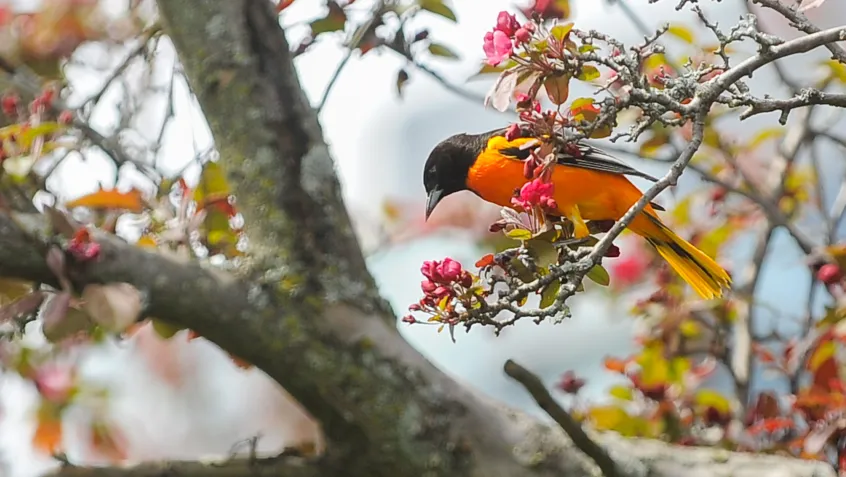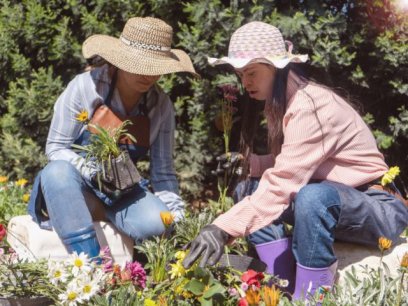
How can you tell that spring is on its way? Whether you're holding out for the first sighting of a robin, crocuses blooming where there once was snow, or buds appearing on your neighborhood trees, you're probably using phenology to determine when the seasons are starting to shift.
What is Phenology?
Phenology is the study of the timing of life cycle events in plants and animals, such as flowering, migration, and crop stages. These life stages, or phenophases, are directly impacted by the local weather and climate, responding to environmental changes such as variations in temperature and precipitation. With their responsiveness to changes in their natural surroundings, wildlife and their phenophases serve as important signal flags of environmental trends and variability, providing valuable information for health professionals, the agricultural sector, natural resource managers, emergency responders, and more.
The timing of important events such as growing seasons, allergy seasons, and fire seasons can vary widely from year to year, but by monitoring and analyzing trends in phenology across a wide geographic region, scientists can better predict when to expect the start and end of these events. For instance, health professionals can use data on plant phenophases to determine when to prepare their patients for allergy season, and farmers can use this information about plant and insect phenology to decide the best time to apply herbicides and pesticides to their crops. Emergency responders and natural resource managers both have an interest in using phenology to determine where and when fire season will begin over an area, using this information to help keep the public safe.
How can I get involved in Phenology?
Using phenology to make these kinds of decisions requires many, many data points across a wide geographic range and a deep time scale. It can be difficult for scientists to gather this much data themselves, so this type of observation and data collection benefits from contributions from the public. You can get involved and try your hand at phenological observation—you can make important contributions from your own backyard!
- Nature's Notebook is a citizen and professional science program sponsored by the US Geological Survey and the USA National Phenology Network. Anyone can participate in this program, which teaches participants to use status monitoring, an approach that has participants visit a site regularly to check the phenological status of marked plants and animals included in the 1,000 species covered by Nature's Notebook. In 2017, the site hit a milestone with the submission of their 10 millionth phenological record, all collected over the course of their decade-long existence by individuals, partners, and groups through Nature's Notebook.
- Project Budburst is a national network of citizen scientists who specifically monitor plants. This is another program open to anyone, where individuals, duos, or groups make careful observations of the timing of leafing, flowering, and fruiting phases of plants throughout the year. Formerly supported by the National Ecological Observatory Network and the National Science Foundation, now a project of the Chicago Botanic Garden, this program allows participants to commit to a long-term period of observation of a single plant, or to enter in data as a one-time event. There are many short-term challenges for participants to engage in, such as the Cherry Blossom Blitz happening from February through the end of April.
Sources:
- Posthumus, Erin. 2016. “See What We Accomplished Together in 2015.” USA National Phenology Network. Accessed March 18. http://archive.constantcontact.com/fs171/1102731551578/archive/1123663261412.html
- Posthumus, Erin. 2017. "National Phenology Network Hits 10M Records." UA News. April 24. https://uanews.arizona.edu/story/national-phenology-network-hits-10m-records
- Project BudBurst. 2016. “Cherry Blossom Blitz.” National Ecological Observatory Network, Inc. and the Chicago Botanic Garden. Accessed March 18. http://budburst.org/cherry?utm_source=March_2016&utm_campaign=March+2016&utm_medium=email
- USA National Phenology Network. n.d. “Towards a USA-National Phenology Network.” USA National Phenology Network. http://training.usgs.gov/TEL/NaturesNotebook/NNSlideNotes.pdf
- USA National Phenology Network. 2016. “USA National Phenology Network: Taking the Pulse of Our Planet.” USA National Phenology Network. Accessed March 18. https://www.usanpn.org/
- USGS, USA National Phenology Network & University of Arizona. 2015. “How to use the Nature's Notebook Citizen Science Program.” US Department of the Interior, USA National Phenology Network & University of Arizona. http://training.usgs.gov/TEL/NaturesNotebook/NNSlideNotes.pdf


